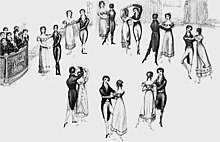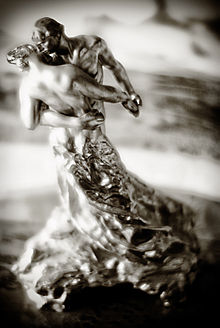Waltz
phenakistoscope animation by Eadweard Muybridge demonstrating the waltz | |
| Genre | Ballroom dance |
|---|---|
| Time signature | 3 4 |

The waltz (from
4 time), performed primarily in closed position
History
There are many references to a sliding or gliding dance, including
In the 1771 German novel Geschichte des Fräuleins von Sternheim by Sophie von La Roche, a high-minded character complains about the newly introduced waltz among aristocrats thus: "But when he put his arm around her, pressed her to his breast, cavorted with her in the shameless, indecent whirling-dance of the Germans and engaged in a familiarity that broke all the bounds of good breeding—then my silent misery turned into burning rage."[5]
Describing life in
In the 19th century, the word primarily indicated that the dance was a turning one; one would "waltz" in the polka to indicate rotating rather than going straight forward without turning.
Shocking many when it was first introduced,[9] the waltz became fashionable in Vienna around the 1780s, spreading to many other countries in the years to follow. According to contemporary singer Michael Kelly, it reached England in 1791.[10] During the Napoleonic Wars, infantry soldiers of the King's German Legion introduced the dance to the people of Bexhill, Sussex, from 1804.[11]
It became fashionable in
The waltz, especially its closed position, became the example for the creation of many other ballroom dances. Subsequently, new types of waltz have developed, including many folk and several ballroom dances.
Variants
This section needs additional citations for verification. (May 2019) |



In the 19th and early 20th century, numerous different waltz forms existed, including versions performed in 3
4, 3
8 or 6
8 (sauteuse), and 5
4 time (5
4 waltz, half and half).
In the 1910s, a form called the Hesitation Waltz was introduced by
The Country Western Waltz is mostly progressive, moving counter clock wise around the dance floor. Both the posture and frame are relaxed, with posture bordering on a slouch. The exaggerated hand and arm gestures of some ballroom styles are not part of this style. Couples may frequently dance in the promenade position, depending on local preferences. Within Country Western waltz, there is the Spanish Waltz and the more modern (for the late 1930s- early 1950s) Pursuit Waltz. At one time it was considered ill treatment for a man to make the woman walk backwards in some locations.[20]
In California, the waltz was banned by Mission priests until 1834 because of the "closed" dance position.[21] Thereafter a Spanish Waltz was danced. This Spanish Waltz was a combination of dancing around the room in closed position, and a "formation" dance of two couples facing each other and performing a sequence of steps.[21] "Valse a Trois Temps" was the "earliest" waltz step, and the Rye Waltz was preferred as a couple dance.[22]
- In contemporary Slow waltz.[23]
- In
- International Standard Waltzhas only closed figures; that is, the couple never breaks the embrace.
- The open dance figure, in which the follower alternates between the lead's left and right sides, with the lead's left or right arm (alone) providing the lead. Waltzes were the staple of many American musicals and films, including "Waltz in Swing Time" sung by Fred Astaire.[citation needed]
- The Scandinavian Waltz, performed as a part of Scandinavian folk dance, can be fast or slow, but the dancers are always rotating.[citation needed]
- The Peruvian Waltz is called and recognised in Peru as vals criollo.[citation needed]
- The Sobre las Olas" or "Over the Waves”.
- The Cajun Waltz is danced progressively around the floor, and is characterised by the subtle swaying of the hips and step very close to ordinary walking. It is danced entirely in the closed position.[citation needed]
- The Cuban (or Tropical) Waltz follows the pattern of the standard waltz throughout the song.[citation needed]
- The Venezuelan waltz provided a basis for distinctive regional musical composition.[citation needed]
- The Contra Waltz (Freeform Waltz), included in most modern jive and salsa. Basically the dancers progress around the dance floor with a waltz step, but with no constraints on what moves they can use.[citation needed]
- The Valse Musette, a form of waltz popular in France, started in the late 19th century.[citation needed]
- The cross-step waltz (French Valse Boston) developed in France in the early 20th century and is popular in social waltz groups today.[citation needed]
- In folk dance from the bal folk, waltzes in even higher metres are played and danced.
- Estonian folk dance Labajalavalss (flat of the foot waltz) performed in 3
4 time.[26] - Sama'i (also known as usul semai) is a vocal piece of Ottoman Turkish music composed in 6/8 metres. This form and metre (usul in Turkish) is often confused with the completely different Saz Semaisi, an instrumental form consisting of three to four sections, in 10/8 metre, or usul aksak semai (broken semai in Turkish). Semai is one of the most important forms in Ottoman Turkish Sufi music.[27][28]
- The Tsamikos (Greek: Τσάμικος, Tsamikos) or Kleftikos (Greek: Κλέφτικος) is a popular traditional folk dance of Greece, done to music of 3
4 metre.[29]
References

- ^ Etymology Online
- ^ a b Nettl, Paul. "Birth of the Waltz." In Dance Index vol 5, no. 9. 1946 New York: Dance Index-Ballet Caravan, Inc. pages 208, 211
- ISBN 978-0-399-11167-9.
- ^ Sir George Grove, John Alexander Fuller-Maitland, Adela Harriet Sophia (Bagot) Wodehouse. A Dictionary of Music and Musicians (A.D. 1450–1880) Published 1889. Macmillan
- ^ The History of Lady Sophia Sternheim, trans. Christa Baguss Britt (State University of New York Press, 1991), p. 160.
- ISBN 1-4179-9311-1.
- ^ Wechsberg. The Waltz Emperors. 1973. C. Tinling & Company. page 49, 50)
- ^ Grove's Dictionary, page 385
- ^ Gutman, Robert W. (1999). Mozart: A Cultural Biography. Harcourt. pp. 44–45.
- ^ Scholes, Percy. The Oxford Companion to Music. 10th edition, 1991. page 1110
- ^ Sussex Weekly Advertiser, 21 January 1805
- ^ Hilton, Boyd (2006). A Mad, Bad, and Dangerous People? England 1783–1846. Oxford University Press.
- ^ Raikes, Thomas (1856). A Portion of the Journal Kept by Thomas Raikes from 1831 to 1847: Comprising Reminiscences of Social and Political Life in London and Paris During that Period. pp. 240–243. Retrieved 20 September 2015.
- ^ "Introduction to 'The Waltz'". Readbookonline.org.
- JSTOR 30212687.
- ISBN 978-0-7112-3245-7.
- ^ Penguin edition 1964, page 42
- ^ ISBN 978-0-415-97440-0.
- ^ "The History of Ballroom Dance in America". Archived from the original on 2011-03-06. Retrieved 2010-12-13.
- ^ Shaw, Lloyd (1939). Cowboy Dances. The Caxton Printers. pp. 101–103.
- ^ a b Czarnoski, Lucile K (1950). Dances of Early California Days. Pacific Books. p. 44.
- ^ Czarnoski, Lucile K (1950). Dances of Early California Days. Pacific Books. p. 121.
- ^ "Information on Styles of Waltz include American, International, C&W, Viennese Waltz and others!". Dancetime.com. 2012-09-09. Retrieved 2017-10-02.
- ^ Vallely, F. (1999). The Companion to Traditional Irish Music. New York: New York University Press. pp. 431–433.
- ^ "Rhythm Definitions - Irish Traditional Music Tune Index". Irishtune.info. 2012-07-11. Retrieved 2012-11-07.
- ^ "Estonian". Common Ground on the Hill. Retrieved 2020-05-17.
- ISBN 9780791411551. Retrieved 30 December 2016.
- ^ "AllMusic Review by James Manheim". AllMusic. Retrieved 30 December 2016.
- ^ "yamahamusicsoft". Archived from the original on 1 January 2017. Retrieved 1 January 2017.
External links
- Waltz basic steps
- Music regarding: Waltz within traditional dances of the County of Nice (France)
- Scroll to "Five Step Waltz" for notes about probable 1847 origin and associated music published the same year.
- Thomas Wilson's 1816 Waltz Manual
- The Dance of Death at Project Gutenberg (1877 Book critical of the Waltz)
- The Regency Waltz
- Waltzes under CreativeCommons licence on BalLibre.org
- Wedding Waltz
